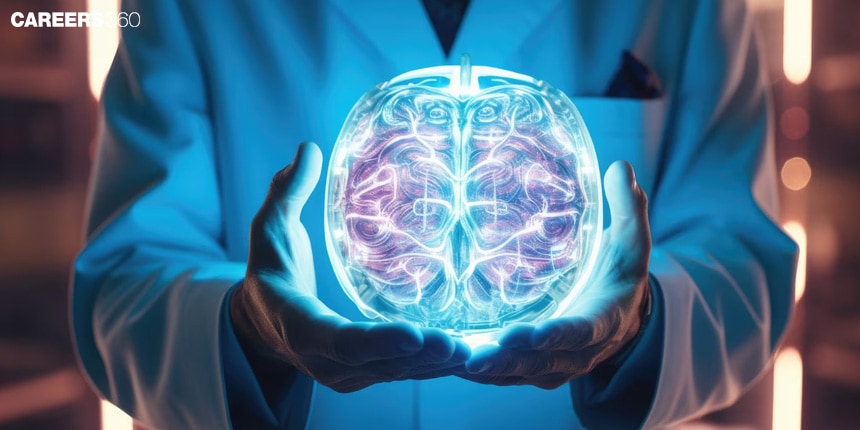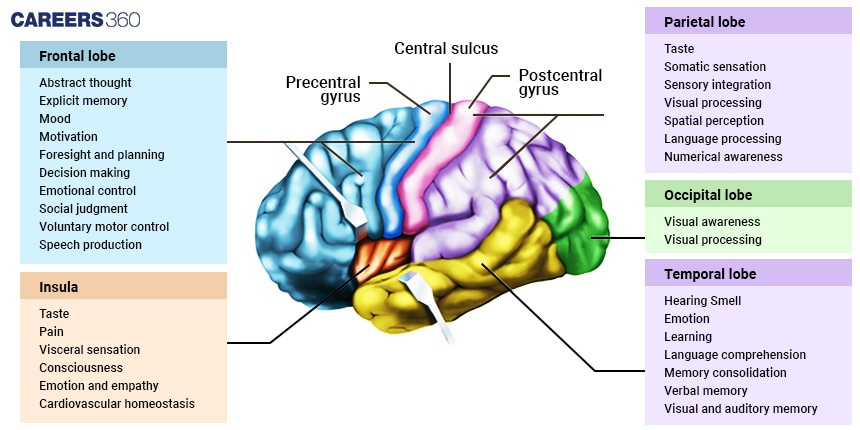Lobes of Cerebrum: Definition, Diagram, Function, Structure, Topics
The lobes of the cerebrum are the main parts of the brain that control functions useful for everyday activities, such as sensation, movement, memory, language, and perception. The main divisions of the cerebrum include the frontal, parietal, temporal, and occipital lobes. Understanding the structure and functions of these lobes is an important topic in Class 11 under the chapter Neural Control and Coordination. Questions from this topic are asked in competitive exams like NEET and AIIMS BSc Nursing, where biology is a major subject.
This Story also Contains
- What are the Lobes of the Cerebrum?
- Structure and Functions of each Lobe
- Communication Among Lobes
- Recommended Video on Lobes of the Cerebrum

What are the Lobes of the Cerebrum?
The cerebrum is separated into four lobes, which include the frontal, parietal, temporal, and occipital. The different lobes are associated with unique functions within our general cognitive abilities and senses. Each of these lobes allows us to understand how the brain can make sense of and put together different forms of information.
Also Read:
- MCQ Practice on Cerebrum
- Neural Control and Coordination
- Human Brain
- Chemical Coordination and Integration
Commonly Asked Questions
Structure and Functions of each Lobe
The structure and function of each lobe are:
Frontal lobe
Location: The position of the frontal lobe is at the front side of the brain, just behind the forehead.
Functions
- Responsible for higher cognitive functions such as decision-making, planning, problem-solving, and judgment.
- Regulates voluntary motor control, thus enabling us to move various parts of the body voluntarily.
- Here, Broca's area plays an important part in speech production and expression of language.
- Involved in personality traits, regulation of emotions, and social behaviour.
- Controlling attention, impulse control, and working memory.
Parietal Lobe
Location: It is situated directly at the back of the frontal lobe, at the top of the brain.
Functions
- It is responsible for the processing of sensory inputs such as touch, temperature, pain, and pressure.
- Helps in perceiving space, the orientation of the body, and coordination.
- It is involved in the integration of different sensory information from various modalities, which helps us move around and live in our environment.
- The somatosensory cortex here helps process sensations from the skin, muscles, and joints.
Temporal Lobe
Location: Both sides of the brain, near ears, and down to the bottom part of the brain
Functions
- The main key for hearing is the auditory cortex which processes sound information
- Crucial function for memory making, especially if it involves the hippocampus and deals with long-term memory and spatial navigation.
- Also deals with the processing of the language. There is an area called Wernicke's area, which helps with the understanding of spoken and written language.
- This contributes to emotional responses as it is involved in emotion regulation and behaviour management of the limbic system.
- Helps in the detection of faces, objects, and locations.
Occipital Lobe
Located at the back part of the brain behind the parietal and temporal lobes
Functions
- The visual cortex here interprets the information received from the eyes.
- Analyze and interpret conditions of vision, which include colour, shape, motion, or depth.
- Convert visual stimuli into meaningful images that can be used in visual perception to understand the environment.
- Assists in the identification of objects and facial features by using visual input.

Commonly Asked Questions
Communication Among Lobes
The communication among the lobes is explained through:
Inter-lobe Communication
Neural networks extend from the lobes interconnecting them in integrating information for advanced cognitive processes.
In a way, communication is essential for the existence of coordinated and coherent brain functions.
Cortical and Subcortical Connections
The cerebral cortex from each lobe communicates with subcortical structures in controlling a variety of activities that go on in the brain.
The connection provides for the effective processing and response to sensory and motor stimulation.
Cognitive Abilities
Each lobe is specialised for different aspects of cognitive functioning, from aspects like reasoning and planning in the frontal lobe to memory processing in the temporal lobe.
The integration eventually gives way to complex thoughts and behaviour.
Sensory Perception
The lobes process sensory information and allow us to perceive and respond to our environment.
For example, the occipital lobe processes visual stimuli, while the parietal lobe processes tactual information.
Also Read:
| Autonomic Nervous System | Sympathetic Nervous System |
| Difference Between Brain and Spinal Cord | Reflex Action and Reflex Arc |
| Nerve Fibres | Cerebrospinal Fluid |
Commonly Asked Questions
Recommended Video on Lobes of the Cerebrum
Frequently Asked Questions (FAQs)